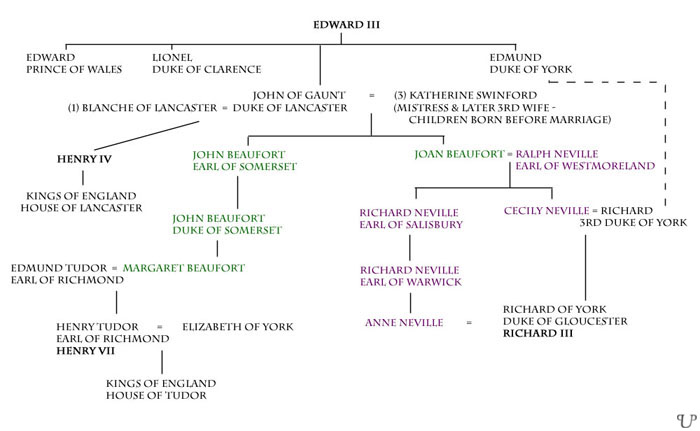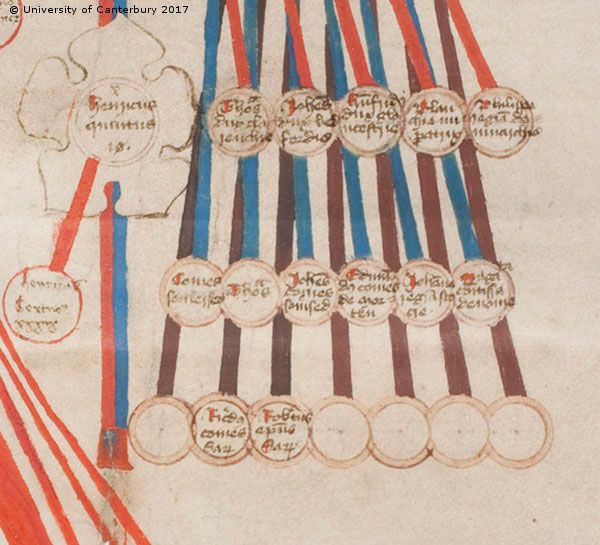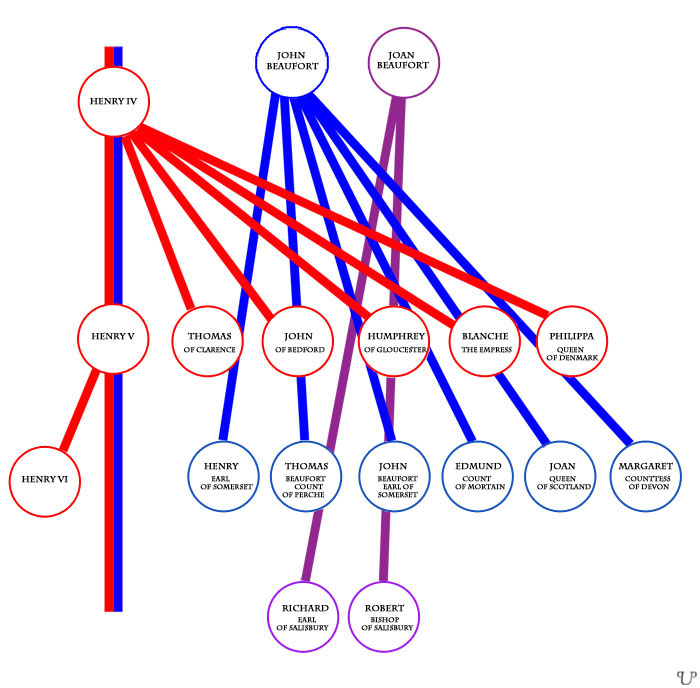
Noble Origins?
The Canterbury Roll may have originated as an officially endorsed Lancastrian document. Yet, it is also possible that it was actually associated with a non-royal noble family.
The development of genealogical manuscripts can be linked to practical and social concerns among the land-owning class of medieval England. "Family trees" were important as they traced ownership of property and had legal implications. They were sources of information and were sometimes used as evidence for inheritance claims, whether for land or the right to bear arms. Given this medieval tradition amongst the nobility, it is important to consider the possibility that the Canterbury Roll was originally commissioned by a noble family.
Beauforts & Nevilles
In 15th-century England, there were several families with a stake in royal genealogies. Our Roll is likely to have a connection with two of these powerful families: the Nevilles and the Beauforts.
The Beauforts were the legitimized children of John of Gaunt, duke of Lancaster and his mistress and later third wife, Katherine Swinford. The Nevilles were a powerful northern family in Westmorland that married into the royal families of England.
The significance of both families is shown in a genealogy of the descendants of John of Gaunt.
Nevilles and Beauforts in the Wars of the Roses

The above is not the complete family tree of the Beauforts or the Nevilles, but demonstrates the relationships between the two families and the succession of kings in England.
The Neville marriages into the Beaufort and York families gave them a particular interest in the dynastic struggles of the 15th century. The family's marked presence on the Canterbury Roll suggests the possibility of their involvement in its creation.
A connection between both families and the Roll is suggested by the detailed insertion of their names along the lower right side of the central axis. The names and titles of these individuals are surplus to requirement if the Roll's aim was simply to illustrate the succession of the Lancastrian kings. Their inclusion suggests that the scribe planned to create an association in the mind of the reader between the monarch and these families. Moreover, other powerful families with close connections to the royal houses, such as the Holands, the Staffords, and the Mortimers rarely feature on the original version of the Roll. This strengthens the possibility that it was originally commissioned to favour the Beauforts/Nevilles.
The following section of the Roll shows the Beauforts and Nevilles alongside Henry V and Henry VI.

Top row: Henry V alongside his royal siblings (red lines)
Second row: The Beauforts descended from John Beaufort (blue lines)
Third row: Richard & Robert Neville descended from Joan Beaufort (purple lines)
Only two of the bottom row of roundels are occupied. These name Richard Neville, the fifth earl of Salisbury, and his brother Robert, bishop of Salisbury. The five empty roundels on the same row might have originally been intended for the names of the other surviving Neville siblings. The placement of an entire generation of the Nevilles beside the original central axis is suspiciously close to the empty space – a space that is reserved for the next king of England.
If we trace the purple "lines" of the two Neville brothers back to their origin we find their mother – Joan Beaufort, countess of Westmorland. Directly above the Neville brothers, there is a row of roundels (descended from the blue lines) that lead to their cousins, the Beauforts. Above them (descended via the red lines) are the siblings of Henry V.
The below genealogy transcribes (and translates into English) the key relationships in this section of the Roll.
Lancaster – Beaufort – Neville

This unusual focus on the extended non-royal families of Neville and Beaufort suggests that the Canterbury Roll may have been commissioned by a pro-Lancastrian party associated with either of these two noble houses.
Perhaps the motive was to emphasize how close the Neville/Beaufort families were to the crown. It may also have been to suggest an alternative line of Lancastrian succession in a time of uncertainty: Henry VI was a child at the time the Roll was originally created and had no siblings. As the original scribe abandoned the project without completing the blank roundels and we are uncertain whether Henry VI was ever included on the central axis, ultimately the exact nature of this connection remains mysterious.
MSH